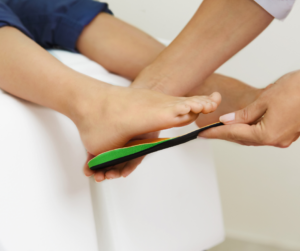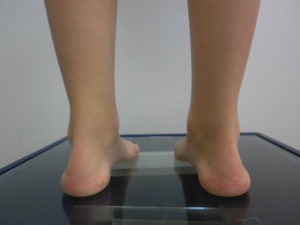 In-toeing is the position where the feet turn in to face one another, and is often referred to as pigeon-toeing. For many kids, in-toeing is a normal part of early development as kids learn to walk and find their feet. While this foot position should correct itself before the age of four, it can persist and cause tripping, falling, clumsiness and pain as a result of these incidents.
In-toeing is the position where the feet turn in to face one another, and is often referred to as pigeon-toeing. For many kids, in-toeing is a normal part of early development as kids learn to walk and find their feet. While this foot position should correct itself before the age of four, it can persist and cause tripping, falling, clumsiness and pain as a result of these incidents.
When in-toeing persists, specific orthotics called gait plates can be used to encourage the feet to turn out. Today, we’re sharing what gait plates are and how they may be able to help your child with their in-toeing.
What Is A Gait Plate Orthotic?
Unlike traditional orthotics, where the ‘functional’ area often finishes just before the ball of the foot, gait plate orthotics extend to the end of the toes on one side of the foot. These orthotics encourage the foot to turn outwards and straighten. Gait plates are worn inside a child’s normal shoes, as long as they can accommodate orthotics, including joggers, school shoes, and everyday shoes. The orthotics are used alongside other treatments that address factors that may be contributing to in-toeing including addressing muscular tightness or imbalances.
Numerous studies on the efficacy of gait plates have shown significant reductions in the angle of in-toeing, as well as reductions in the frequency of tripping, both in the short and long-term.
 Are They Comfortable?
Are They Comfortable?
Yes! Kids adapt really well to wearing gate plates, often forgetting they’re in their shoes at all. Studies have shown that parents report high satisfaction with gait plates, particularly as they are non-invasive so generally do not cause pain.
How Long Must Gait Plates Be Worn?
This depends on the severity of the in-toeing to begin with and the adherence to all treatment components – especially when it comes to addressing the cause of the in-toeing. You’ll know when it’s safe to stop wearing them, not just because your podiatrist will tell you at the child’s check-up appointment, but because your child will be walking straight ahead.
What Else Needs To Be Done?
As with any problem we address here at My FootDr, the long-term success lies in not only treating the symptoms, but getting to the cause of the problem. As the causes of in-toeing often include muscular tightness or imbalance, physical therapy using gentle stretching and strengthening is often part of the treatment plan too.
We never prescribe a gait plate without performing a comprehensive kids’ foot health assessment, so we understand exactly what is happening with your child’s feet and why. After this assessment, an individual treatment plan will be created for your child, and we’ll talk you through every component, what it involves, and its purpose.
Are Orthotics Covered By Private Health Funds?
If you have podiatry cover for your family, you may be eligible for a rebate on your orthotics every year. This is great when it comes to getting a second pair of orthotics for multiple shoes, so you can stop moving them from shoe to shoe. Check your eligibility with your health fund to confirm.
Ready To Book Your Appointment?
If your child is in-toeing, or you’re worried about any other pains or problems, bring them in to your My FootDr Podiatrist. We love helping families with their foot health so they can lead happy, healthy and active lives.
Book your appointment online here


